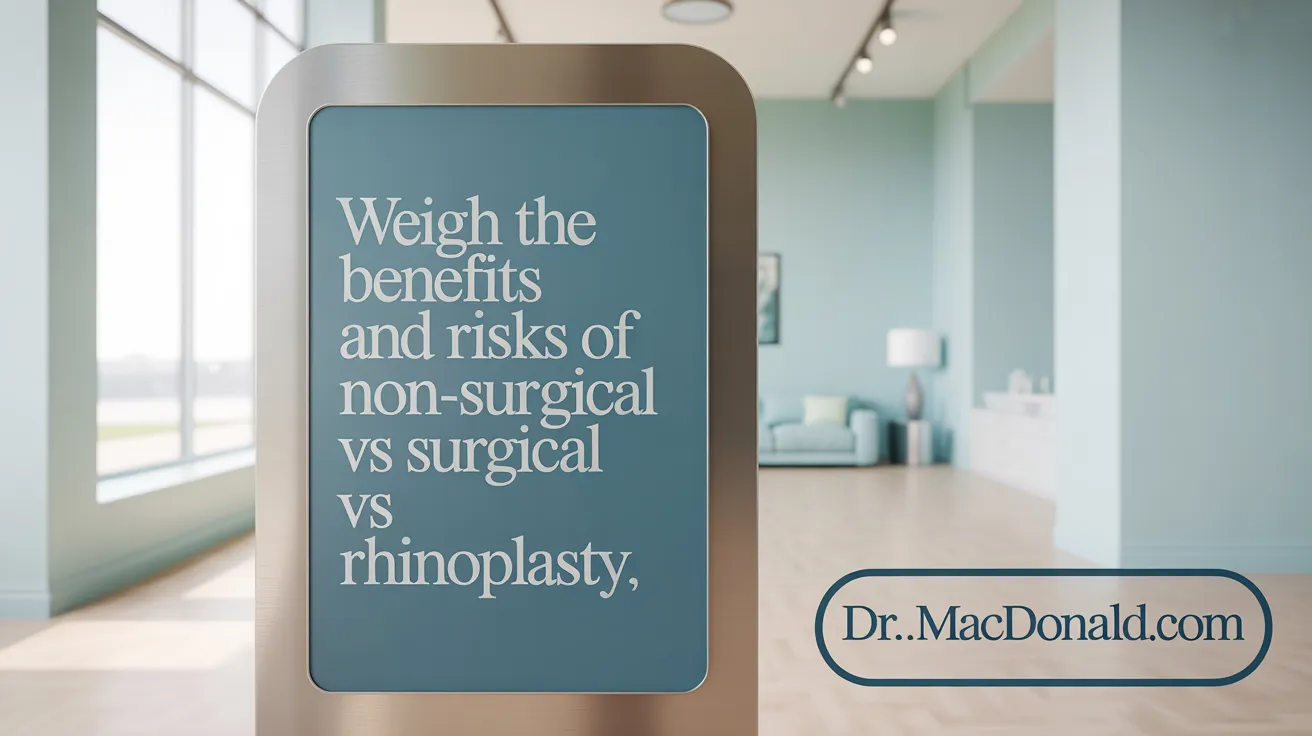Exploring Your Options for Nose Reshaping
Choosing between non-surgical and surgical rhinoplasty is a significant decision influenced by your aesthetic goals, medical needs, and lifestyle preferences. This article provides a comprehensive comparison of these two popular procedures, examining their differences, advantages, risks, recovery, and ideal candidates to help you make an informed choice.
Understanding Non-Surgical and Surgical Rhinoplasty: Fundamental Differences

What is the difference between non-surgical and surgical rhinoplasty?
Non-surgical rhinoplasty, also known as a liquid or filler rhinoplasty, involves the use of injectable dermal fillers like hyaluronic acid to make temporary adjustments to the nose's shape. This minimally invasive procedure typically takes about 30 minutes, delivers immediate results, and allows patients to return to normal activities quickly. The changes achieved are subtle, such as smoothing bumps, lifting the nasal tip, or enhancing symmetry. However, since it only adds volume, it cannot reduce the overall size or alter the underlying bone and cartilage structure. Its effects usually last between 6 to 12 months, requiring repeating treatments to maintain the look.
In contrast, surgical rhinoplasty involves a more invasive approach, where a plastic surgeon reshapes the nasal bone, cartilage, and skin through incisions. This procedure generally takes 2 to 4 hours and provides permanent, more significant changes. It can address a wide range of issues, including correcting large nasal bumps, narrowing the nose, fixing deformities, or improving breathing function. The recovery time from surgery ranges from 1 to 2 weeks for initial healing, with swelling and residual effects subsiding over months. Surgical rhinoplasty offers lifelong improvements, making it suitable for those seeking permanent and substantial modifications.
| Feature | Non-Surgical Rhinoplasty | Surgical Rhinoplasty | Details |
|---|---|---|---|
| Procedure Type | Injectable fillers | Precise reshaping through surgery | Differences in invasiveness |
| Main Purpose | Subtle, temporary changes | Permanent and major modifications | Scope of correction |
| Duration of Results | 6-12 months | Permanent | Longevity |
| Treatment Time | About 30 minutes | 2-4 hours | Time required |
| Recovery & Downtime | Minimal; same-day return | Several days to weeks | Recovery process |
| Cost | Generally more affordable | Higher cost (e.g., around £5000) | Financial considerations |
Choosing between these two options depends on your aesthetic goals, the extent of correction needed, and your willingness to undergo surgery. Consulting with a qualified specialist will help determine the most suitable procedure for your individual needs.
Pros and Cons: Evaluating Benefits and Drawbacks of Each Procedure

What are the pros and cons of non-surgical versus surgical rhinoplasty?
Non-surgical rhinoplasty, often called a liquid nose job, involves injecting dermal fillers such as hyaluronic acid to make subtle adjustments to the shape of the nose. One of its main advantages is that it is minimally invasive, performed quickly—typically within 30 minutes—and requires no downtime. Patients see immediate results and can easily reverse the effects with the use of hyaluronidase if needed. It is also more affordable than surgical options, with costs generally much lower.
However, non-surgical rhinoplasty has its limitations. The results are temporary—lasting about six months to up to two years depending on the filler used—and only suitable for minor corrections. It cannot make the nose smaller or narrower, nor can it address significant structural deformities or functional issues like breathing difficulties. Repeated treatments are necessary to maintain the look, which can cumulatively increase costs over time.
On the other hand, surgical rhinoplasty offers permanent and more dramatic changes. It allows for comprehensive reshaping of the nose, including reducing size, correcting asymmetries, and fixing structural problems that affect breathing. The results are long-lasting and often considered permanent after healing. But this procedure involves higher costs, often around £5000 or more, along with a longer recovery period—typically from a few weeks to several months of swelling subsiding. Risks are greater, including bleeding, infection, scarring, and the potential need for revision surgeries.
In summary, non-surgical rhinoplasty excels in providing quick, reversible, and affordable corrections suitable for minor imperfections, making it ideal for testing aesthetic outcomes or making subtle refinements. Surgical rhinoplasty is better suited for those aiming for significant, permanent changes or requiring correction of functional issues. Choosing between the two depends on individual goals, the extent of correction needed, budget, and willingness to undergo recovery.
Determining the Right Candidate for Each Rhinoplasty Approach
Who is an appropriate candidate for non-surgical versus surgical rhinoplasty?
Candidates suitable for non-surgical rhinoplasty are typically those who have minor nasal concerns that do not require structural changes. These include subtle bumps, small asymmetries, slight drooping of the nasal tip, or a mild dorsal irregularity. Such patients usually prefer to avoid the risks and recovery time associated with surgery.
Non-surgical rhinoplasty is ideal for individuals looking for quick, reversible, and minimally invasive improvements. They should have realistic expectations, understanding that the results are temporary—lasting from about six months to a year—and limited to adding volume or smoothing minor imperfections.
On the other hand, surgical rhinoplasty is better suited for patients needing significant alterations. This includes correction of major deformities, severe deviations, or functional issues like breathing problems. Those seeking permanent, more dramatic changes or structural modifications should consider surgical options.
Candidates for surgical rhinoplasty often have complex or pronounced nasal irregularities that cannot be fixed with fillers alone. They are typically prepared for a longer recovery and the possibility of future revisions.
It is essential for both types of patients to consult with qualified facial plastic surgeons to evaluate their nasal anatomy, discuss goals, and determine the most appropriate procedure.
Both approaches require patients to have no active infections, inflammation, or underlying conditions that could impair healing or increase surgical risks. Realistic expectations and clear communication with healthcare professionals are vital for achieving satisfactory results.
Risk Profiles and Recovery: What to Expect Post-Procedure

What are the risks and recovery differences between non-surgical and surgical rhinoplasty?
Non-surgical rhinoplasty is a quick, minimally invasive procedure that uses dermal fillers like hyaluronic acid to reshape the nose temporarily. It typically takes about 30 minutes and allows patients to return to their daily routines immediately, with most experiencing little to no downtime. Common side effects include minor redness, swelling, or bruising at the injection sites, which usually resolve within a few days. Rare but more serious complications involve vascular issues such as blood vessel blockage, which can lead to tissue necrosis, or, in very rare cases, blindness. These risks highlight the importance of having the procedure performed by a highly trained and experienced specialist.
In contrast, surgical rhinoplasty involves permanently altering the nasal structure through a surgical process that may last 2 to 4 hours under general anesthesia. Recovery from surgery is more extended, typically requiring 1 to 2 weeks of initial downtime to allow swelling and bruising to subside. There is also a longer-lasting healing process, with persistent swelling and changes continuing for several months. Risks specific to surgical rhinoplasty include bleeding, infection, scarring, and even the need for revision surgeries if outcomes are unsatisfactory.
The primary difference lies in the permanence and scope of the results. Non-surgical rhinoplasty offers a safe, flexible option with immediate, temporary improvements suitable for minor corrections, while surgical rhinoplasty provides a permanent solution for more significant structural changes, albeit with a higher risk profile and longer recovery.
Choosing between these options depends on individual goals, the extent of nasal alterations desired, and willingness to undergo recovery and potential risks. Consulting with an experienced rhinoplasty surgeon is essential to determine the best approach tailored to personal needs.
| Aspect | Non-Surgical Rhinoplasty | Surgical Rhinoplasty | Description |
|---|---|---|---|
| Procedure Duration | About 30 minutes | 2 to 4 hours | Length of the procedure |
| Recovery Time | Immediate, minimal or no downtime | 1 to 2 weeks of initial downtime | Time to return to normal activities |
| Duration of Results | 6 to 18 months, depending on filler used | Permanent | Length of the aesthetic outcome |
| Common Side Effects | Redness, swelling, bruising, filler migration | Swelling, bruising, scarring, discomfort | Typical post-procedure reactions |
| Serious Risks | Vascular complications, rare blindness, necrosis | Infection, bleeding, scarring, need for revision | Potential severe complications |
| Best For | Minor adjustments, test cosmetic outcomes | Significant shape changes, functional corrections | Suitable cases for each procedure |
| Practitioner Requirement | Must be performed by experienced professionals | Performed by qualified, experienced surgeons | Qualification importance |
Understanding these differences helps ensure patients make informed decisions that align with their aesthetic goals and safety considerations.
Results and Longevity: Comparing Outcomes Over Time

How do the results of non-surgical and surgical rhinoplasty differ in terms of longevity and appearance?
Non-surgical rhinoplasty, often called a liquid rhinoplasty, provides quick, subtle enhancements to the nose's shape with immediate results visible right after the procedure. These effects are temporary, typically lasting between six months and up to two years, depending on the type of dermal filler used and individual metabolism. It is ideal for minor adjustments such as smoothing bumps, lifting the tip, or camouflaging imperfections without altering the nose's structure permanently. The appearance after non-surgical rhinoplasty tends to be natural and refined but can be easily adjusted or reversed.
In contrast, surgical rhinoplasty involves permanent reformation of the nose's bony and cartilaginous structure. This procedure creates lasting results that can significantly change the size, shape, or asymmetry of the nose. Once healed, the results are generally lifelong, making it suitable for individuals seeking a significant and enduring transformation. Surgical rhinoplasty can also correct functional issues like breathing difficulties, which non-surgical methods cannot address.
The visual and structural differences reflect the nature of each approach: non-surgical methods offer minor, temporary adjustments perfect for testing aesthetic outcomes or subtle improvements. Surgical rhinoplasty, however, provides extensive, permanent changes that alter the nose's overall shape and functionality.
Regarding costs, non-surgical rhinoplasty tends to be more affordable initially but may require frequent touch-ups to maintain the desired look, potentially increasing long-term expenses over time. Surgical rhinoplasty involves a higher one-time cost but results in long-lasting effects, reducing the need for ongoing treatments.
Choosing between these options depends on individual goals, whether seeking a reversible, subtle enhancement or a permanent, more dramatic nose transformation. Consulting with a qualified specialist can help determine the most suitable approach based on desired longevity and outcomes.
Making an Informed Choice: Factors to Consider and Next Steps

Assessing personal goals and nasal anatomy
Before deciding on a rhinoplasty procedure, it’s essential to evaluate your aesthetic goals and nasal anatomy. Non-surgical rhinoplasty is suitable for subtle changes, such as smoothing bumps, lifting the tip, or adding volume to small areas. It is ideal for minor imperfections and minor asymmetries but cannot reduce nose size or address large deformities. On the other hand, surgical rhinoplasty offers permanent and more dramatic changes, such as reducing the overall size or correcting severe deformities.
Budget considerations
Cost is a significant factor in choosing the right procedure. Non-surgical rhinoplasty is generally less expensive, with costs usually lower because it’s less invasive and involves fewer resources. Traditional surgical rhinoplasty tends to be more expensive, often costing around £5000 or more, depending on complexity and location. Additionally, non-surgical procedures require maintenance treatments every 6 to 18 months, which can increase long-term costs. It’s important to consider your budget and long-term expenses when making your decision.
Willingness to undergo surgery and recovery
The recovery process varies considerably. Non-surgical rhinoplasty involves minimal downtime, allowing you to return to daily activities immediately, with results lasting up to a year. Surgical rhinoplasty requires a longer recovery period of about 1 to 2 weeks for initial healing, with swelling potentially lasting several months. If you prefer a quick procedure with minimal recovery, non-surgical options may be more appealing. However, if you are comfortable with surgery and seek permanent results, traditional rhinoplasty may be better suited.
Consultation importance with qualified surgeons
A consultation with an experienced facial plastic surgeon is crucial. They can assess your nasal structure, discuss your goals, and recommend the most appropriate procedure. A qualified surgeon will also inform you about potential risks, the expected results, and whether non-surgical rhinoplasty can meet your expectations or if surgery is necessary. This personal assessment ensures a safe procedure tailored to your needs.
Using non-surgical rhinoplasty as a preview tool for surgery
Non-surgical rhinoplasty can serve as a useful preview for those considering permanent surgical changes. By testing aesthetic outcomes with dermal fillers, you can see the potential results before committing to surgery. This approach helps manage expectations and decide whether permanent surgery is the right choice. Keep in mind, while it provides a temporary change, surgery offers permanent, structural modifications for lasting satisfaction.
Deciding the Best Rhinoplasty Approach for You
Both non-surgical and surgical rhinoplasty offer unique benefits tailored to different needs and preferences. Non-surgical rhinoplasty provides a quick, safe, and reversible option for those seeking minor refinements without downtime, while surgical rhinoplasty is the definitive solution for permanent, substantial reshaping and functional improvement. A thorough consultation with an experienced specialist is essential to evaluate your individual anatomy, goals, and health, enabling an informed decision that aligns with your expectations and lifestyle. Ultimately, understanding the pros and cons, risks, recovery, and results of each procedure empowers you to choose the method best suited for your aesthetic and functional desires.
References
- The Pros and Cons of Non-Surgical Rhinoplasty
- Nonsurgical Rhinoplasty (Nose Job): What It Is, Uses & ...
- Surgical Rhinoplasty vs Non Surgical Nose Job
- Pros and Cons of Non-Surgical Rhinoplasty
- Comparing Non-Surgical and Traditional Rhinoplasty
- Non-Surgical Nose Job VS Traditional Rhinoplasty
- Liquid Rhinoplasty (Non-Surgical) vs. ...
- Traditional vs. Non-surgical Rhinoplasty - San Mateo, CA
- Liquid vs Surgical Rhinoplasty Explained
